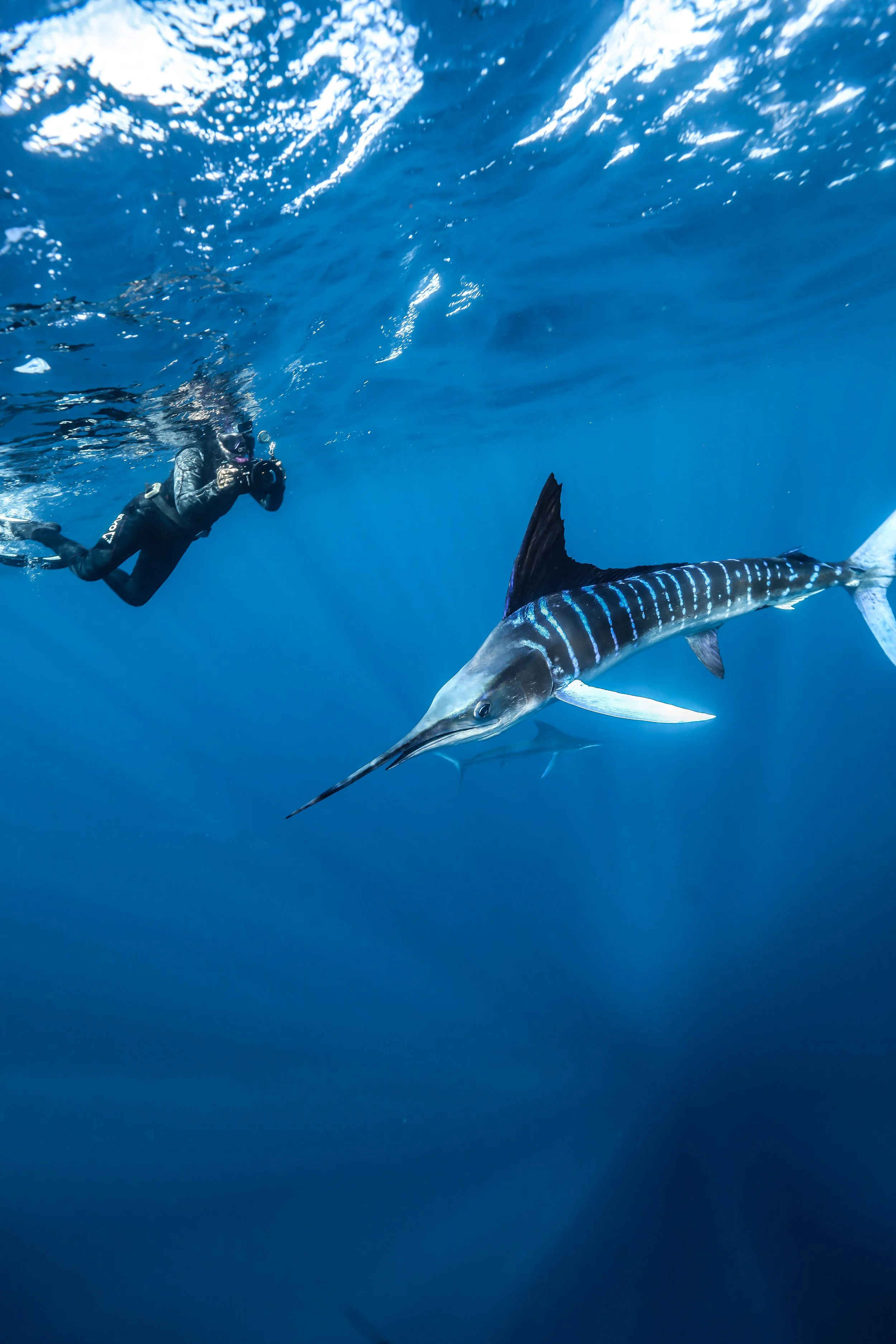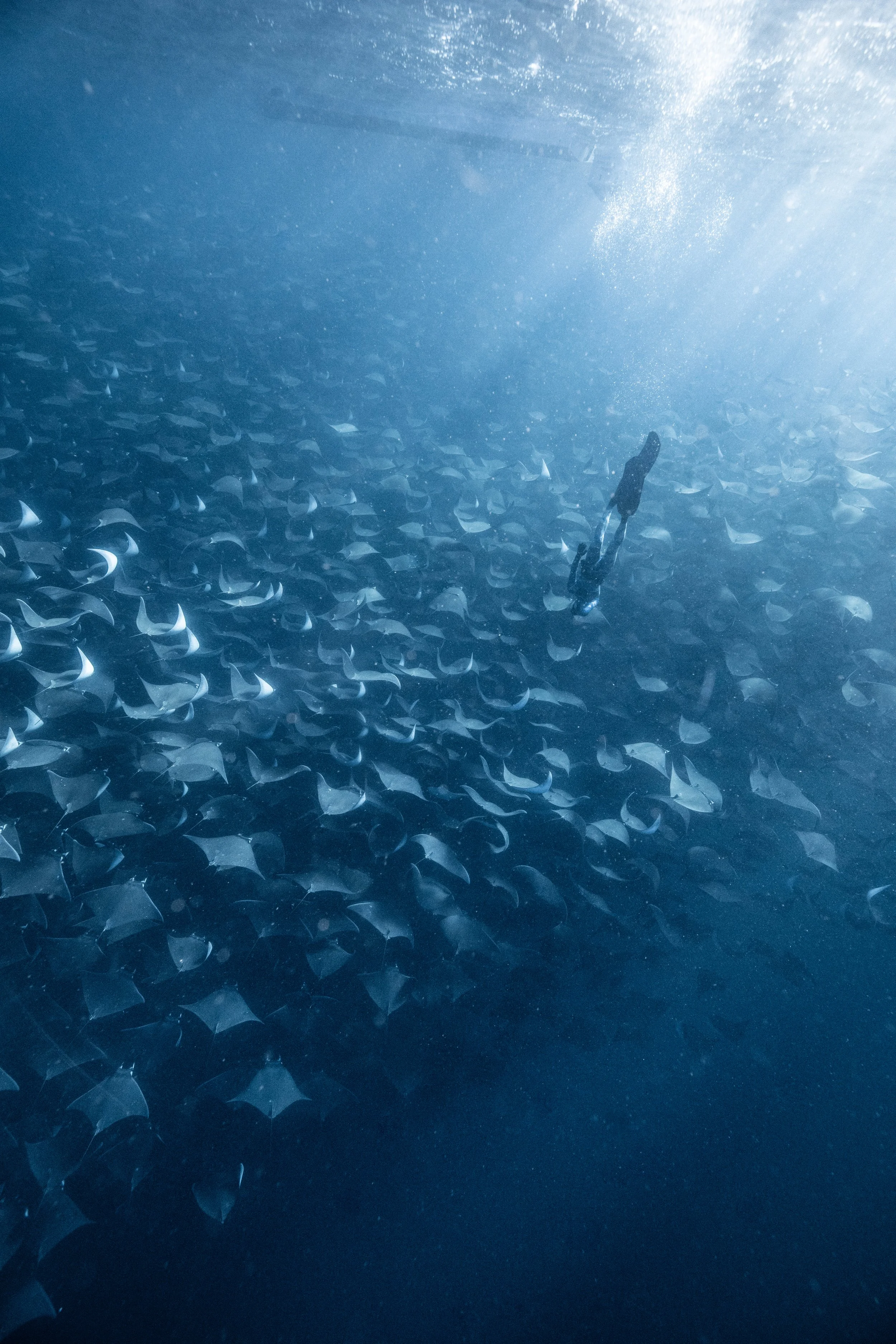The Mexican Sardine Run:
The Wildest Show in the West
Marlins, sea lions, whales, and dolphins chase rivers of sardines in an explosion of life.
This is Bahía Magdalena in November—and I’m taking just 6 guests into the heart of the action.
6 Days / 5 Nights in Baja
November 21-26th, 2025
4 open-ocean expeditions
5 nights boutique accommodation
Two onboard professional photographers
All meals included (alcohol not included)
Swim with marlin, sea lions, dolphins, whales & more
Explore mangroves and desert sand dunes




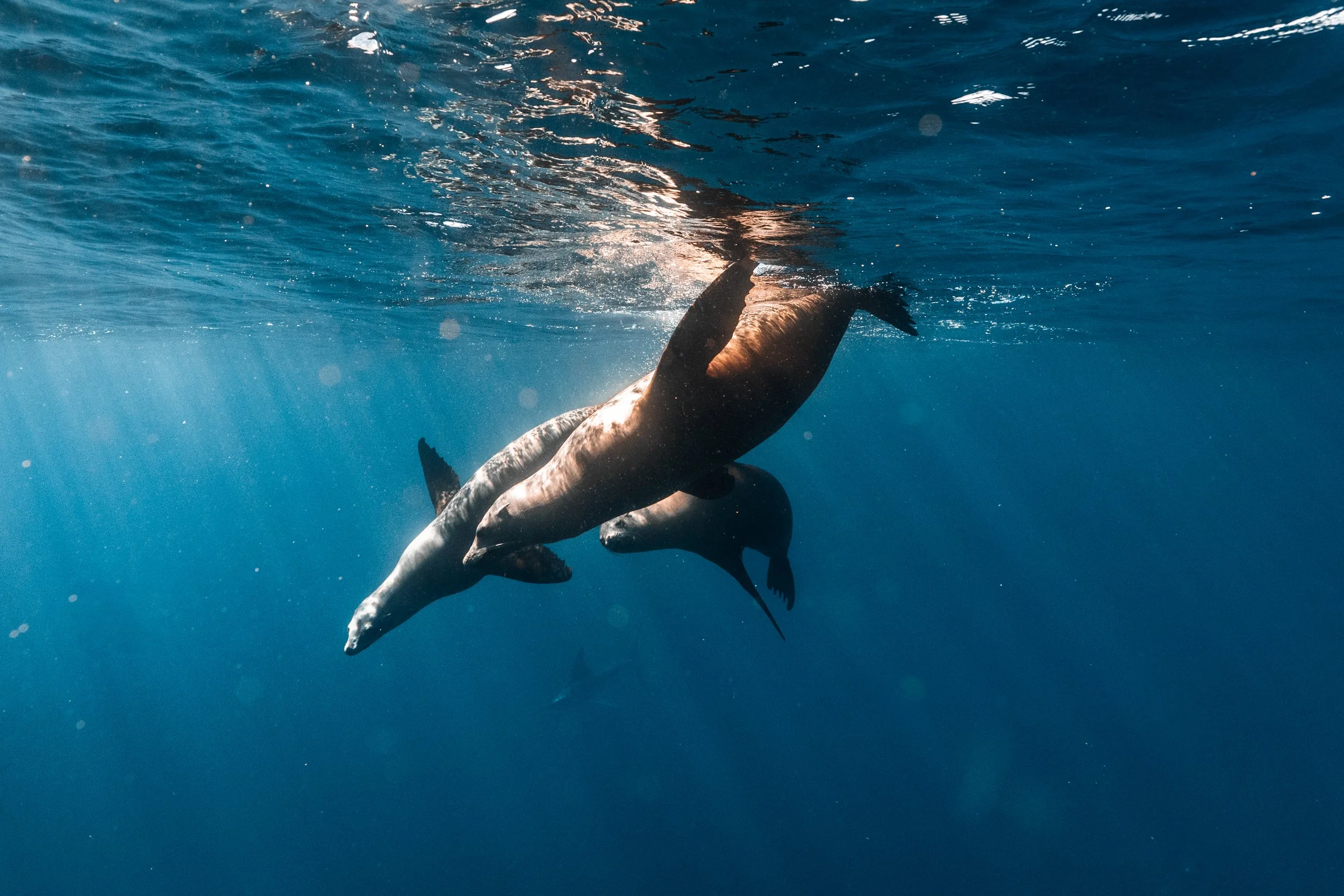



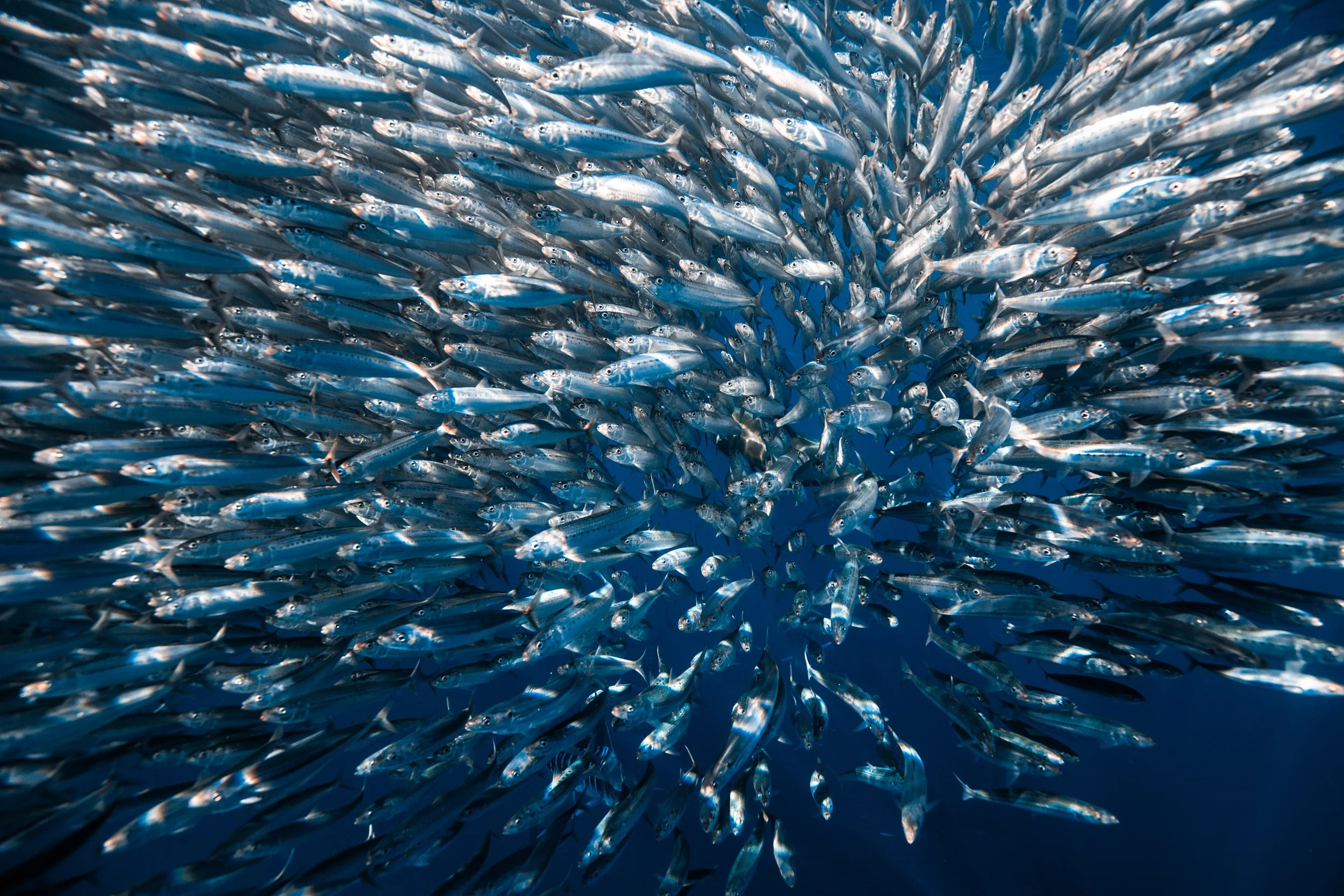




Your Baja Expedition Details
Six days of wildlife encounters, ocean exploration, and unforgettable photography—everything you need to know before you join us.
-
📅 Day 1 (Nov 21) – Arrive in La Paz
Settle into your hotel, enjoy a sunset stroll on the beautiful Malecón (boardwalk), and join the group for a welcome dinner + expedition briefing.📅 Day 2 (Nov 22) – First Safari (Puerto Chale) → Transfer to San Carlos
Early departure to Puerto Chale for our first ocean safari from the southern bay. After a full day at sea and a local sustainable seafood lunch, we continue north to San Carlos and check in to our coastal hotel.📅 Day 3-4 (Nov 23–24) – Ocean Safaris & Mangrove/Sand Dune exploration from San Carlos
Two full days exploring launching from the northern region of Bahía Magdalena by boat. We’ll be searching for bait balls, marlins, dolphins, whales, and more. We’ll also visit the mangroves and sand dunes- an experience not to be missed. Evenings include optional photo editing sessions, breathwork, mobility work, sunsets and shelling.📅 Day 5 (Nov 25) – Final Safari → Return to La Paz
One last morning safari launching from the south from Puerto Chale. After lunch, we drive back to La Paz for our final dinner and overnight stay.📅 Day 6 (Nov 26) – Departures
Morning breakfast and airport transfers. End of expedition. -
Roundtrip ground transportation from La Paz to San Carlos
5 nights accommodation (double occupancy, AC with own bathrooms)
4 full days at sea with experienced guides
All in-water guiding and safety support
All meals, snacks, and drinks daily (if you are vegan or vegetarian or don’t eat seafood we CAN absolutely accommodate but you must let us know ahead of time)
All professional photography and media, alongside photography educational support
Mobility and breath work geared toward Sea Safari and open ocean work.
Dive weights
-
Flights
Freediving/snorkeling gear (rentals available, including wetsuits)
Alcohol
Travel insurance (required)
Gratuities and personal expenses
-
-Full Snorkel Gear: Mask, fins, weight belt, (weights will be provided). We recommend a 3mm full wetsuit.
-Warm Clothing: it is often cold in the morning and evening
-Wind & sun protection (windbreaker, gloves, hat, face gator, sunglasses)
-
A trip like ours typically runs $3500USD. In honor of our launch, we are running at $3000USD. To secure your space, we require a 50% non refundable deposit, Paid Via Venmo or Wise.
What’s possible?
Target Species (our primary focus during the Sardine Run—nothing is guaranteed, but these are the encounters we’re most confident in):
Sardine bait balls – the core spectacle of the migration
Striped marlin – fast, agile hunters chasing sardines
Dolphins – including bottlenose, common, and spotted species
Seabirds – frigatebirds, pelicans, cormorants, and gulls signaling active feeding frenzies
Sea lions – often hunting alongside marlin and dolphins
Secondary Species (wildlife we may encounter depending on timing, luck, and conditions):
Humpback, Fin, Bryde’s, pilot & false killer whales
Mahi Mahi & other pelagic predators
Mobula rays
Turtles
Sharks – including smooth hammerheads and occasional makos
Other seabirds – shearwaters, boobies, and terns
Sunfish (Mola Mola) – rare but possible in deep waters
Orcas – an infrequent but unforgettable sighting; this trip is not designed for orca encounters
What Makes our Trip Different?
I’ve developed something Totally Unique:
Smarter Access to Magdalena Bay
Magdalena Bay is huge, with wildlife spread between the northern and southern regions.
Most tours launch from only one spot, which means missing out on all the area has to offer.
We launch from both San Carlos (north) and Puerto Chale (south),
so we can cover all our grounds as well as go wherever the wildlife is most active.
No missed opportunities.
More Than Just a Wildlife Tour
This is a raw, ocean-centered adventure led by seasoned freedivers and marine professionals—
not an influencer trip chasing content.
Your experience includes:
Two onboard photographers capturing the wildlife and your moments
Optional evening photo-editing sessions to level up your storytelling
Daily breathwork & mobility to keep you energized for long days on the water
This expedition is about fun, adventure, and connection—
a true encounter with nature, not a checklist.
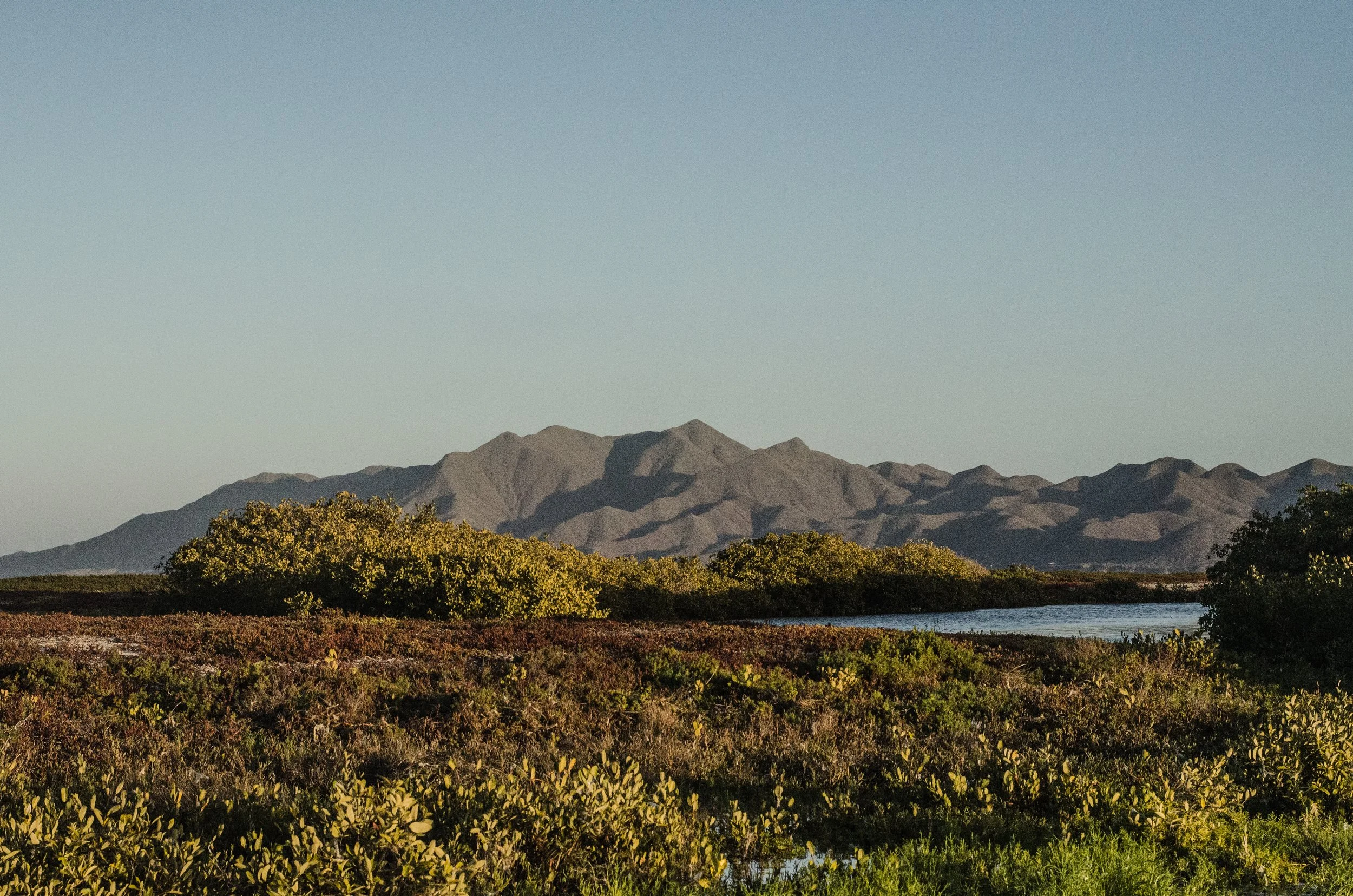
Magdalena Bay INFORMATION
Water temperature
Average: 75°F (24°C)
Range: 67–80°F (19–27°C)
Comfortable for swimming/snorkeling—a 3mm full wetsuit is strongly recommended, especially for long hours in the wateR.
Air Temperature:
Daytime highs: 78–85°F (25–29°C)
Early mornings & evenings: 60–68°F (15–20°C)
Expect warm, sunny days and cooler nights—warm layers are key. And a windbreaker is essential for the mornings/between dives.
WEATHER
This is a coastal desert region. In November, you can expect hardly any rain, warm days and cool nights.
For this open ocean expedition, expect that ocean conditions can be choppy, wavy, & windy.
FAQs
-
The Sardine Run is a wild seasonal event where millions of sardines migrate through the Pacific waters off Bahía Magdalena. These bait balls trigger a high-speed feeding frenzy by striped marlin, sea lions, dolphins, whales, and seabirds. It’s one of the ocean’s most spectacular and unscripted wildlife encounters.
-
The Sardine run gets going from October until end of December. Our expedition runs during the peak of the sardine run in late November, when predator activity (striped marlin, sea lions, dolphins, whales, and more) is typically at its highest.
-
While nature is unpredictable, typical encounters during the Sarding Run in Magdalena Bay include:
Striped marlin hunting sardine bait balls
Sea lions, dolphins, whales (Bryde’s, humpback, possibly orca)
Mobula rays, dorado, tuna, sharks, and a wide variety of seabirds
-
This is an active expedition. You should be a strong swimmer and comfortable snorkeling in deep, open ocean. Days on the boat are long, often 6–8 hours, and water entries can be frequent and fast-paced. If you’ve never done a marine wildlife trip before, we recommend prior ocean experience or reaching out to us for advice.
-
Swimming through a bait ball—especially during a feeding event—is a bad idea for several important safety and ethical reasons:
1. You Become Part of the Chaos
Predators like striped marlin, sea lions, dolphins, and even sharks are attacking the bait ball at high speed—often from all directions.
If you swim through the bait, you can:Get accidentally struck by a predator’s bill, tail, or body
Disrupt the natural flow of the hunt, causing unpredictable reactions
Be mistaken as a threat or even prey in low visibility or fast action
2. It can scare the Bait Ball
Bait balls are formed as a last-ditch defense. When a human swims through them:
The school panics and breaks formation, scattering the fish
Predators lose the tight hunting opportunity and may abandon the site
You risk ruining the encounter for everyone—including your own group
3. Its disrespectful of the Wildlife Experience
This is a natural event, not a theme park. Swimming aggressively through a bait ball is:
Disruptive to predator-prey dynamics
Dangerous to both animals and humans
Poor etiquette in responsible wildlife tourism
-
Yes—**freediving is allowed and often the best way to experience the action**—but it’s important to know that this is not a depth-focused trip. Most of the wildlife encounters happen at or near the surface.
That said, if you're a confident freediver, you’ll be able to drop beneath the bait balls, dive below the chaos, and find angles that snorkelers can’t. I’ll be in the water too, and if you want tips, breathwork, or feedback during the trip, I’m happy to share what I know.
Just remember: this is about respectful observation, not chasing. The animals are wild, fast, and working in high-alert hunting mode. We dive slow, move gently, and stay clear of the bait. You will receive expert guidance about whether it’s okay to dive or not.
If you're not a freediver yet, don't worry—you'll still have incredible experiences at the surface.
-
No. Most wildlife encounters happen at or near the surface. Freedivers are welcome, but snorkelers will be able to participate fully and safely.
-
Yes! We have two professional photographers on board who will document wildlife encounters and your time in the water. You’ll receive a selection of edited images after the trip. We also offer nightly photo editing and storytelling sessions if you'd like to learn how to improve your own underwater photography.
-
Absolutely. Most guests join solo and leave with a tight-knit crew of fellow ocean lovers. You’ll be paired with another solo traveler for accommodations unless you request a private upgrade.
-
It’s best suited for intermediate to advanced snorkelers or freedivers. If you're unsure whether this trip is right for your skill level, we’re happy to chat with you and help assess. You don’t need to be an elite athlete—but you should feel at ease in deep water and be comfortable on boats.
-
We can’t guarantee sightings of any specific animal—this is a wild, unscripted natural event, and conditions vary day to day. That said, striped marlin are the primary predator during the sardine run, and they are seen on most expeditions. Whales (including Bryde’s, humpbacks, and occasionally orcas) are regular visitors to these waters, especially in late fall, but their presence can be more unpredictable.
What we can guarantee is that our team uses real-time scouting, local knowledge, and flexible launch strategies to give you the best possible chance of seeing—and safely swimming near—these incredible animals. No two days are the same, and that’s part of what makes this expedition so thrilling.
-
We operate with deep respect for marine life, local communities, and the ecosystems we explore. Here’s what sets our expeditions apart:
Wildlife-first approach: We never chase, corner, or harass animals. Our guides are trained to read behavior and maintain respectful distances. If wildlife moves on—we let it.
Small group size (max 6 guests): This minimizes stress on wildlife and avoids the chaos of large boats or crowded interactions.
Local partnerships: We work with local boat captains, stay in locally owned accommodations, and contribute to the regional economy in a sustainable way.
Education & awareness: Every guest is briefed on ocean etiquette, predator-prey dynamics, and how to behave responsibly in the water. We believe the best experiences come from understanding and humility—not control.
Leave no trace: We pack out what we pack in, avoid single-use plastics, and promote ocean-friendly practices on land and sea.
Our goal isn’t just to show you something wild—it’s to help you connect with it in a way that protects and preserves it.
-
Great question! The morning air is quite chill, but the water of the temperature range Magdalena Bay is not typically that cold (67–80°F (19–27°C). Couple that with getting in and out of the boat and a long day on the water , are we recommend everyone have at least a 3mm full wetsuit. as well as bring a windbreaker. Check out this overview of Magdalena Bay conditions.
-
No age limit, however you do need to be comfortable with a potentially rough boat ride & swimming in the open ocean.
-
Absolutely. I am personally really passionate about accommodating people when it comes to food allergies, restrictions, or ethics. However, just understand that:
1. people will be eating seafood on this trip.
2. I will do my best to make sure your meals are tasty, but do not expect extravagant meals.
3. I need to know ahead of time to be able to support you.

“The Closer our lives come to the earth, the more real and meaningful they become.”
Out there—where the ocean teems with life and every moment demands presence—is where we remember what it means to feel alive.
Join me for an expedition that strips away the noise and drops you into the wild heart of it all.
